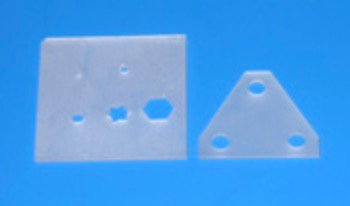
Industrial Sapphire Window Overview
An industrial sapphire window is a transparent component made from high-purity α-Al₂O₃ (aluminum oxide) single crystals, processed through controlled crystal growth, precision cutting, and polishing. Its key features include:
-
Exceptional Hardness and Wear Resistance
Sapphire ranks 9 on the Mohs hardness scale—second only to diamond (10)—providing outstanding scratch resistance and durability to maintain optical clarity even in harsh conditions. -
Broad Spectral Transmission
It offers strong transmission from the ultraviolet (UV, ~200 nm) through the near-infrared (NIR, ~5 µm) range, with visible light transmission exceeding 80%, making it suitable for diverse optical detection and imaging applications. -
High-Temperature and Chemical Stability
With a melting point around 2040 °C and inherent chemical inertness, sapphire windows can operate reliably in high-temperature, high-pressure, and corrosive chemical environments. -
Moderate Thermal Expansion Coefficient
Its coefficient of thermal expansion closely matches that of metals and quartz, minimizing thermal stress and ensuring dependable sealing between the window and its mount.
Applications
-
Optical and Laser Systems
-
Used as laser cavity windows, spectrometer windows, and protective covers for photodetectors.
-
Ideal for UV and IR imaging systems where high transmission is critical.
-
-
Semiconductor and Electronics Manufacturing
-
Viewing ports for CVD/PECVD reactors, resistant to plasma corrosion.
-
Observation windows in ion implanters and etching chambers that operate under high temperature and high vacuum.
-
-
Aerospace and Defense
-
Protective windows for missile seekers, electro-optical sensor enclosures, and infrared guidance systems, capable of withstanding extreme temperatures and mechanical shocks.
-
-
Medical and Scientific Instruments
-
Optical windows for biological microscopes, laser surgical tools, and infrared imaging detectors.
-
-
Oil & Gas and Automotive Industries
-
In-line flow monitors, process control viewports, and sight glasses for high-pressure or corrosive vessels.
-
Manufacturing Process Summary
-
Crystal Growth
Large-diameter single-crystal sapphire boules are typically grown via the Modified Heat Exchanger Method (HEM) or the Kyropoulos technique. -
Cutting and Pre-Processing
Diamond wire or diamond saws slice the boule into blanks of the desired thickness, followed by coarse grinding to remove surface irregularities and residual stress. -
Precision Grinding and Polishing
Multiple precision grinding steps culminate in a final nano-polishing stage, achieving surface flatness and smoothness down to approximately Ra ≤ 0.5 nm for minimal optical scatter. -
Quality Inspection and Optional Coating
-
Instruments such as interferometers and white-light profilometers verify thickness tolerance, parallelism, and surface roughness.
-
Anti-reflective (AR), high-reflective (HR), or long-wave infrared (LWIR) coatings may be applied to optimize transmission or reflection characteristics for specific wavelength ranges.
-
